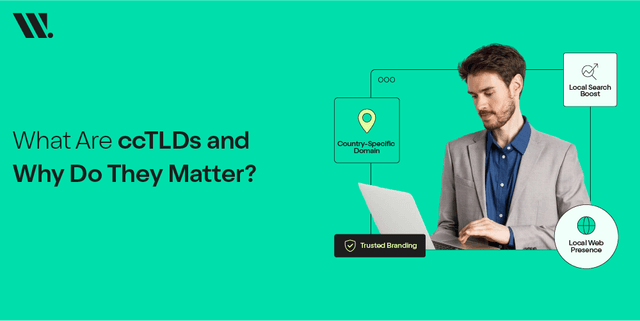Have you ever been puzzled how to quickly interlink your favorite domain name server with your domain hosting provider? Concerned about what the best settings are for your website to have the best speed and security?
Follow us as we guide you through the complicated world of the internet.
We'll address these queries conjointly in order to help you become a master of crafting a visually striking website!
1. Introduction
1. Importance of Domain-Hosting Connection
A key element of creating a strong online presence is the relationship between hosting and domain names.
A website's domain acts as its unique address, and domain hosting offers the systems required to store and distribute its content. For consumers to have a dependable and effective online experience, hosting and domain management must work together seamlessly.
Strong connections make it easier to quickly and securely access websites, which improves user experiences and lends authority to the site.
Additionally, it is essential to search engine optimization (SEO), which affects how visible and highly ranked a website appears in search results.
A strong domain & hosting relationship is essential for individuals, companies, and website owners since it provides the framework for a reliable and reachable online presence.
2. Basics of Domain and Hosting
Domain and hosting are the basics that need to be set up if you want to have an internet presence. A domain name can be considered a unique address of a site that helps users find it by using a familiar and easy-to-remember name.
In contrast, web hosting in Pakistan involves the storage of website files and data on a server so that people from all over the world can visit your site easily.
Taken together, these two entities constitute the bedrock of any online enterprise by providing them with the framework upon which their respective websites operate in terms of functionality and visibility.
2. Registering a Domain
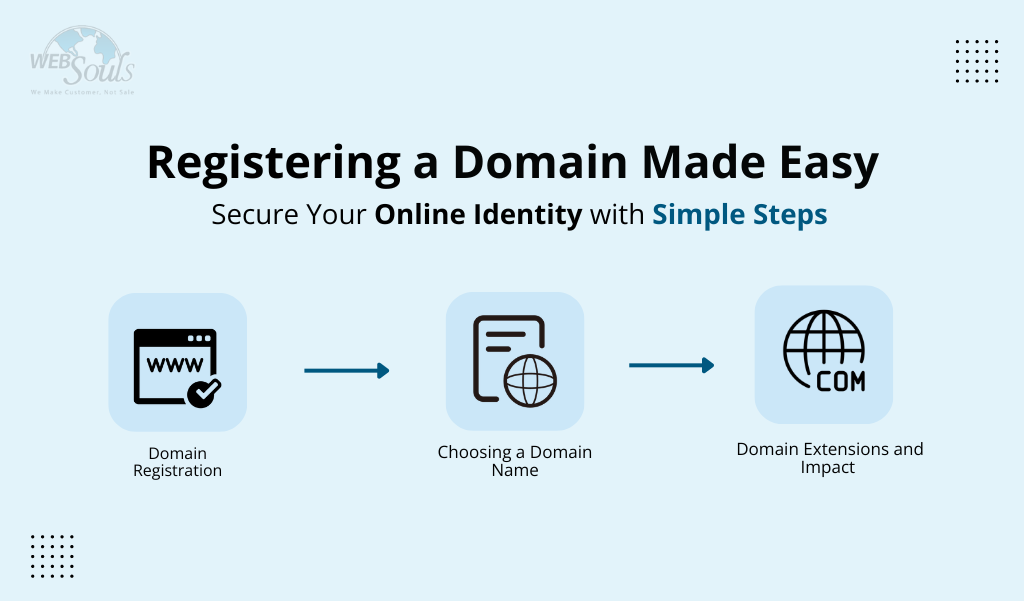
1. Domain Registration Process
A seamless and effective acquisition of a domain name is ensured by a number of essential phases in the domain registration process, which is a critical step in creating an online presence. This is how the procedure is broken down:
a. Domain Availability Check
In order to determine whether their preferred domain name is available, users first search for it.
Users can usually enter their desired domain names in the search box found on a domain registrar's website.
b. Selecting a Registrar
Once the availability of the domain has been verified, customers need to select a trustworthy domain registrar to manage the registration.
Users should take their demands and money into consideration since registrars differ in terms of cost, customer service, and extra services.
c. Create an Account
Users must register by creating an account on the platform of the selected registrar.
This includes generating login credentials, supplying personal information, and contact information.
d. Providing Essential Information
Users are required to enter basic information throughout the registration process, including their name, address, phone number, and email address.
To prevent any problems later on, it is important to make sure that all the facts are correct and current.
e. Selecting Registration Period
Users decide on the duration for which they want to register the domain (e.g., one-year, multiple years). Longer registration periods often come with discounts and prevent unintentional expiration.
f. Adding Domain Privacy Protection
In order to keep private contact details out of the public WHOIS database, several registrars provide a domain privacy protection option.
An additional degree of privacy can be added by users choosing to add this service.
g. Payment and Confirmation
Users go on to the payment step once all information has been submitted and choices have been chosen.
Users receive an email confirming the registration of their domain after making a successful payment.
h. Configure DNS Settings
To connect the domain to a website or email hosting provider, users might need to adjust the domain name system (DNS) settings. By doing this step, you can be confident that users are being appropriately directed to the desired website by the domain.
If users would like to secure a domain name fast and easy, they can simply use these steps to get their online presence up and running quickly.
A reliable registrar should be selected, while it is also necessary that accurate information about the individual concerned should be made available, as well as other optional services which will help ensure a complete and successful domain registration process.
2. Choosing a Domain Name
Making a lasting impression on the internet requires combining science and art in the process of choosing the ideal domain name.
It's the technical factors, such as keyword relevancy, SEO optimization, and spelling consistency, that make the science. But designing a domain that captures the spirit of your business and sticks in the minds of your target audience is where the artistry comes into play.
A short, spell-checkable domain name that conjures up a favorable image of your products is what marks a brand. Finding the ideal balance between distinctiveness and relevancy is essential to making an impression that lasts.
It takes more than simply protecting your website's domain name to build a digital identity that resonates with users and reflects your brand.
You can make sure that your online presence is not just useful but also makes a lasting impression in the broad internet environment by combining the art and science of domain selection.
3. Domain Extensions and Impact
Top-level domains (TLDs), sometimes referred to as domain extensions, are essential in defining a website's identity and determining its influence on the online space.
Selecting a domain extension is a strategic choice with broad consequences that goes beyond simple technical considerations. The enigma associated with domain extensions is their capacity to imply many links and meanings.
For example, corporations like to use the widely used.com domain since it is frequently regarded as a sign of legitimacy and trust.
However, industry-specific TLDs, such as.tech or.blog, might draw in a specialized audience and improve relevance.
From an SEO standpoint, the TLD may be taken into account by search engines when ranking websites, therefore picking a pertinent extension might help improve exposure.
Furthermore, because it contributes to the initial image of the website, the domain extension selection may have a big impact on branding and user perception.
By knowing the subtleties of well-known extensions, like.edu for academic institutions or.org for corporations, website owners may better connect their online presence with their objectives and increase overall effect.
3. Web Hosting Setup
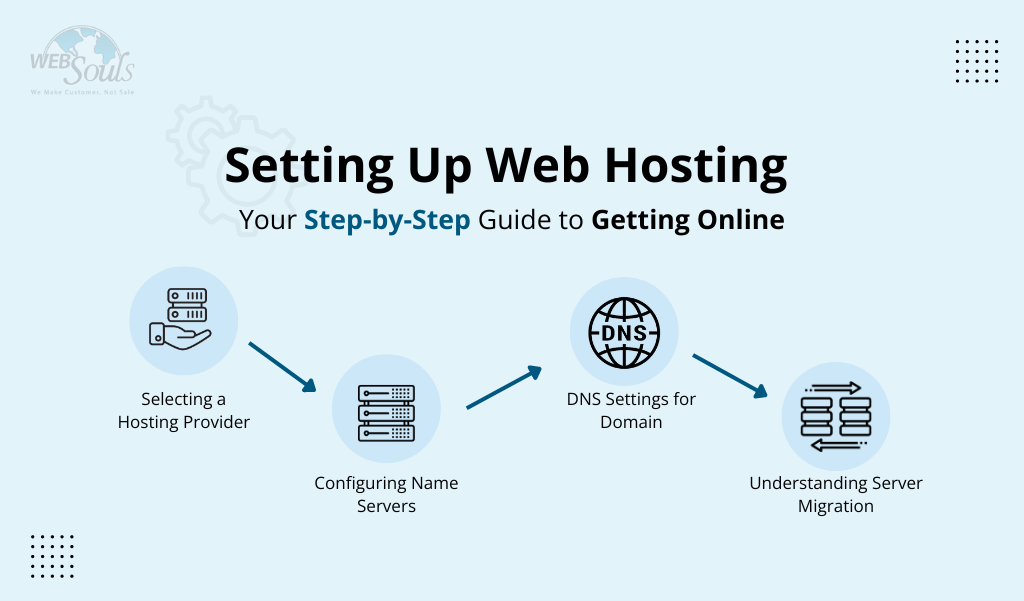
1. Selecting a Hosting Provider
The next important choice that will have a big influence on the functionality and dependability of your website is choosing a domain hosting company.
The abundance of web hosting alternatives available on the market might be overwhelming, but you can make an informed choice by carefully weighing the pros and cons of each option.
First, think about the kind of server that best meets your needs.
While dedicated server hosting offers unique server resources at a premium price, shared hosting is more affordable but might not have enough capacity for websites with heavy traffic.
Offering dedicated resources in a shared environment, virtual private server (VPS) hosting achieves a compromise between cost and performance.
Comprehending the requirements of your website, including traffic volume, storage capacity, and particular software demands, is crucial. It is important to consider aspects like storage capacity, scalability, and bandwidth limits.
Since constant uptime is essential for a flawless user experience, evaluate the provider's dependability by looking at their uptime promises and the quality of their infrastructure.
A firewall, SSL certificates, and frequent backups are examples of characteristics that are crucial for security. Think about the quality of the technical assistance offered, taking into account the team's timeliness and knowledge.
If you're not tech-savvy, take into consideration the hosting platform's ease of use as well.
Gaining insights into other users' real-world experiences may be obtained by reading customer evaluations and asking for suggestions.
Ultimately, the domain hosting provider you choose should align with your website's specific needs and growth potential, ensuring a stable and efficient online presence.
2. Configuring Name Servers
Establishing a seamless connection between your domain and hosting services is of utmost importance, and configuring name servers plays a vital role in achieving this.
It ensures the smooth functioning of your online presence.
To accomplish this, you need to update the DNS (Domain Name System) settings, redirecting your domain to the appropriate domain hosting server. Follow the step-by-step instructions below to successfully configure name servers and synchronize your domain with your hosting:
a. Access Your Domain Registrar Account
Access the account you bought your domain from the domain registrar by logging in.
b. Locate DNS Settings or Name Server Management
Look for choices like "DNS Settings" or "Name Server Management" by navigating to the domain management dashboard.
Depending on your registrar, the language may change.
c. Choose Custom Name Servers
Instead of using the default settings, use the custom name server option.
You may provide the precise name server details that your website hosting provider has supplied by doing this.
d. Obtain Name Server Information from Hosting Provider
Get the name server details by logging into your hosting account or getting in touch with your domain hosting company. Typically, this consists of two or more addresses, such ns1. and ns2.yourhostingprovider.com.
e. Input Name Server Information
On the platform of your domain registrar, enter the supplied name server information in the designated boxes.
Make sure everything is accurate because a single error might cause the link between your hosting and domain to break.
f. Save Changes
After entering the name server information, save the changes. This action initiates the process of updating DNS records, which may take some time to propagate across the internet.
g. Verify Configuration
Periodically check the DNS settings to make sure the changes have taken effect.
To confirm that the domain is referring to the right name servers, you can utilize web resources such as DNS lookup services.
h. Update Hosting Settings if Necessary
Your domain hosting company can occasionally need to do additional setups on their end. For a flawless integration, make sure the parameters in your domain hosting account match those in the domain configuration.
i. Allow Time for Propagation
Remember that it might take up to 48 hours for DNS changes to take effect globally. Users may see sporadic connectivity at this time, but this is a typical procedure.
j. Monitor for Issues
Keep an eye out for any troubles with your email service and website. If issues still arise, verify the name server details and get in touch with your hosting company and domain registrar.
You may create a stable and dependable online experience for your visitors by carefully following these procedures, which provide the groundwork for a synchronized connection between your domain and hosting.
3. DNS Settings for Domain
When a user enters a domain name into their browser, the DNS system resolves that name into an IP address, directing the browser to the correct server hosting the associated website.
The process involves a hierarchy of servers, starting with the authoritative name server for the domain, which holds the definitive records.
DNS settings are made up of several records, including CNAME (Canonical Name) entries for domain aliasing, MX (Mail Exchange) records for email routing, A (Address) records for mapping domain names to IP addresses, and more.
Usually, one may use the control panel provided by the domain registrar to adjust DNS settings for a domain. The IP addresses of the mail servers, domain hosting servers, and other relevant data can be specified here when editing the DNS entries.
When users input your domain in their browsers, precise DNS settings guarantee that they arrive at the desired location.
A website's speed, email delivery, and general online appearance are all greatly impacted by proper DNS maintenance, which also creates a smooth link between your domain and hosting.
Therefore, understanding and configuring DNS settings is an essential aspect of managing and optimizing your online infrastructure.
4. Understanding Server Migration
Transferring data, apps, and other essential components from one server to another is a difficult procedure known as server migration.
Comprehending and effectively implementing server migration is vital for establishments seeking to modernize their infrastructure, improve efficiency, or accommodate evolving technological requirements.
The first step in creating a comprehensive guide on server migration is evaluating the hardware, software, and dependencies of the current server environment.
Determining the purpose of the migration—whether it's to adopt new technologies, increase security, or better scalability—is crucial.
Planning is essential and includes establishing roles and duties within the migrating team, creating realistic timetables, and taking a thorough inventory of available resources.
Communication is key during this phase to ensure that stakeholders are informed and aligned with the migration goals.
Selecting the appropriate migration strategy is an additional crucial phase.
Migrations from virtual to virtual (V2V), virtual to physical (V2P), and physical to physical (P2P) are examples of common techniques.
The choice is based on the particular needs of the company, including budget, hardware compatibility, and tolerance for downtime.
In order to minimize downtime and risks, it is helpful to detect and fix any difficulties before the actual migration through thorough testing of the procedure in a controlled environment.
To guarantee data integrity, a step-by-step strategy should be followed during the migration execution phase, starting with data backup and verification.
Data and apps must be transferred, settings must be updated, and the operation of crucial systems must be verified during the actual migration. To follow the progress and quickly discover any irregularities, performance measurements and monitoring tools should be used.
In order to quickly and without major delays revert to the initial server configuration, it is imperative to have a rollback plan in place in case of unforeseen errors.
Staying clear of typical mistakes is essential for a successful server move.
Extended downtime, data loss, and operational interruptions can result from inadequate planning, inadequate testing, and poor communication.
Organizations should be careful not to make typical errors such as underestimating the time needed for migration and neglecting dependencies and compatibility difficulties.
Maintaining open lines of communication with stakeholders and end users at every stage of the process helps control expectations.
4. Troubleshooting Connection Issues
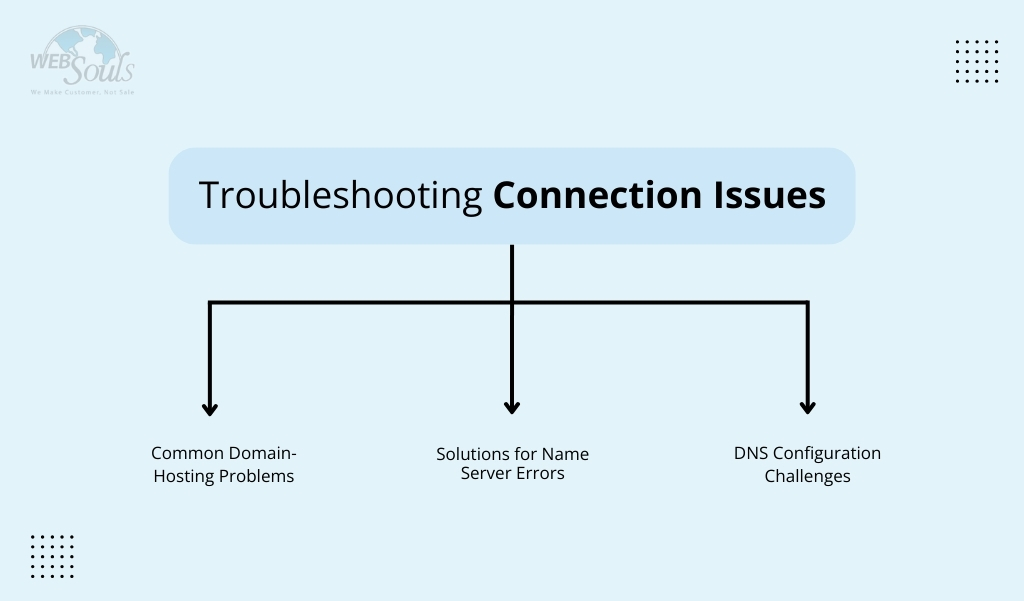
1. Common Domain-Hosting Problems
There are many obstacles to overcome while navigating the complex world of domain hosting, from operational bottlenecks to technological issues. The dreaded downtime—when consumers are unable to access your website—is one frequent obstacle.
Using proactive monitoring tools that notify you of possible problems before they become more serious is essential if you want to prepare yourself for such situations.
Furthermore, server problems might occur and result in a website that is completely unavailable or performs slowly. Comprehending server logs and consistently refining your server's settings might aid in anticipating and addressing such issues.
A further serious risk is security breaches, which can result in anything from reputational harm to data disclosures. Implementing robust security protocols, including SSL certificates and regular vulnerability assessments, is vital for safeguarding your hosted domains.
Domain registration and renewal issues can also disrupt your online presence.
Staying organized with renewal reminders and ensuring your contact information is up-to-date with domain registrars can mitigate these concerns.
Additionally, when integrating third-party programs or plugins, compatibility issues might arise; therefore, maintaining compatibility requires regular updates and a deep grasp of your hosting environment.
Maintaining awareness, taking preventative action, and improving your troubleshooting abilities can help you comfortably negotiate the intricacies of domain hosting and quickly get beyond any obstacles that may arise.
2. Solutions for Name Server Errors
Name server problems can seriously hinder a website's ability to operate properly since they affect the relationship that a domain has with its hosting server.
Incorrect information given for the name servers associated with a domain due to misconfigurations in the DNS (Domain Name System) settings is one of the possible reasons for name server failures.
Furthermore, problems with connection may also be caused by problems with the domain registrar, such as inaccurate or obsolete name server information.
Propagation delays are also a problem; modifications to name server configurations may take time to spread throughout the internet.
Making sure the right name servers are provided in the DNS settings and double-checking them for accuracy is a good way to address these issues.
To rectify any issues stemming from errors made by the domain registrar, it is crucial to verify the information and update any outdated details.
It is important to exercise patience when faced with propagation delays, as allowing sufficient time for the changes to propagate fully can resolve any connectivity disruptions.
In addition, utilizing tools such as DNS lookup services can aid in diagnosing and validating the accuracy of name server configurations.
Taking a proactive approach by regularly monitoring and maintaining open lines of communication with web hosting providers and domain registrars can help prevent potential name server errors and ensure a seamless connection between the domain and hosting server.
Ultimately, by comprehending the potential causes and implementing these effective solutions, one can greatly enhance the reliability and performance of a website by promptly addressing name server errors.
3. DNS Configuration Challenges
One essential but sometimes disregarded component of network administration is configuring Domain Name System (DNS) settings.
As the foundation of the internet, the DNS converts domain names that are readable by humans into IP addresses, enabling smooth device-to-device communication.
Users often have trouble adjusting DNS settings, though, and this can result in poor online experiences, security flaws, and connectivity problems. Choosing the right DNS servers is a frequent source of difficulty.
It might be challenging for users to decide between the DNS servers provided by their Internet Service Provider (ISP) and other third-party options like Google DNS or OpenDNS.
The solution lies in evaluating the performance, security features, and privacy policies of different DNS providers to make an informed decision. Another prevalent issue is the propagation delay that occurs when DNS changes take time to propagate across the global network.
To address this, users can lower the Time-To-Live (TTL) value before making changes, minimizing the delay in updated DNS information dissemination.
Security concerns also arise, with DNS attacks like cache poisoning and DNS spoofing threatening the integrity of the network. By encrypting DNS data with cryptographic signatures to guarantee its integrity and validity, DNS Security Extensions can reduce these dangers.
Furthermore, users frequently undervalue the significance of routine DNS maintenance, which can result in out-of-date entries and possible security flaws.
Maintaining a steady and secure connection is facilitated by establishing a schedule for DNS checks and changes.
To ensure that users have a strong, secure, and dependable internet connection, it is necessary to pick servers carefully, optimize TTL values, implement DNSSEC, and follow a proactive maintenance plan in order to overcome DNS setup issues.
5. Advanced Domain-Hosting Integration
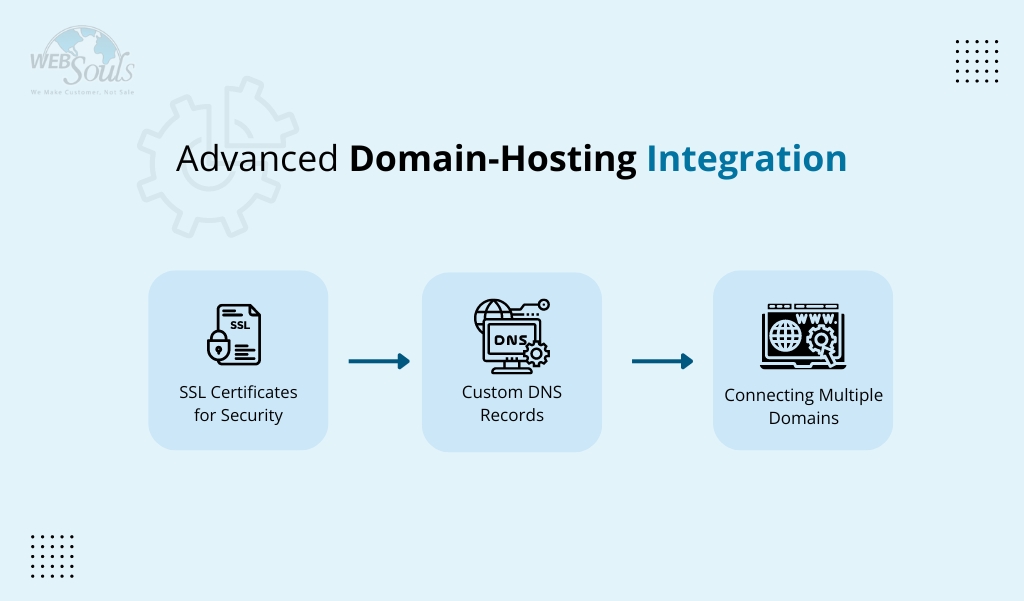
1. SSL Certificates for Security
The security and integrity of data sent over the internet are what depend on the SSL (Secure Socket Layer) certificates to a great extent.
In this case, these digital certificates act as cryptographic keys that establish a secure connection between a user’s web browser and the server hosting a website.
The importance of SSL certificates lies in their ability to encrypt sensitive information including login credentials, credit card details as well as personal data hence avoiding unauthorized access and possible loss of data.
It is important to incorporate your domain-hosting setup with SSL certificates so as to build trust among those visiting your site.
When SSL is embedded in a site, it can be identified by “https://” in its URL and has an icon padlock at the top of the address bar indicating that it has a secured link.
This visual indication lowers the possibility of hostile actors intercepting visitors' data by confirming that it is encrypted during transmission.
Furthermore, SSL is crucial for search engine optimization since Google and other major search engines give websites with SSL certificates higher ranks.
You must install an SSL certificate on the web server and get one from a reliable Certificate Authority (CA) in order to include SSL into your domain-hosting arrangement. The process is not too complicated because a lot of hosting companies give solutions for smooth connection.
Website owners that prioritize SSL certificates not only improve the security of their platforms but also help create a more secure and reliable online environment for their visitors.
2. Custom DNS Records
Custom DNS records open up a vast realm of possibilities for individuals and organizations seeking to optimize their online presence, providing a nuanced level of control over various aspects such as functionality, security, and overall digital strategy.
DNS, or Domain Name System, acts as the backbone of the internet, translating user-friendly domain names into IP addresses that computers understand.
While standard DNS configurations suffice for many users, the ability to customize DNS records allows for a tailored and strategic approach to managing online assets. One key advantage of custom DNS records lies in enhancing functionality.
By leveraging records like CNAME (Canonical Name) or TXT (Text), users can seamlessly integrate third-party services, redirect traffic, or authenticate domains for email services.
This flexibility is particularly valuable for businesses looking to streamline operations and improve user experience.
Moreover, the implementation of custom DNS records plays a pivotal role in bolstering security.
DNS offers various record types, such as SPF (Sender Policy Framework) and DKIM (DomainKeys Identified Mail), which enable organizations to authenticate emails, mitigate phishing attacks, and enhance overall email security.
Furthermore, DNSSEC (DNS Security Extensions) can be employed to add an extra layer of protection by ensuring the integrity and authenticity of DNS responses.
This is crucial in safeguarding against DNS spoofing and other malicious activities.
Additionally, custom DNS records empower users to exert precise control over their online assets.
Through records like SRV (Service) or MX (Mail Exchange), businesses can designate specific servers for particular services, thus optimizing resource allocation and ensuring efficient functioning of critical operations.
Furthermore, utilizing DNS for load balancing or failover strategies enhances the reliability of web services.
3. Connecting Multiple Domains
Interconnecting a range of sectors in one single hosting environment is also an intelligent and convenient way which can help users to make their online presence more effective, increase the resource efficiency as well as simplify management.
In business enterprises, organizations or individuals who run various sites, some of them with different intentions, this method is highly effective.
By merging these domains into a collective hosting environment, users can standardize their authority over them and reduce the intricacies of managing distinct hosting accounts.
This makes it easier for resources to be allocated in a streamlined manner making it possible to scale up or down based on each domain’s ever-changing needs.
Normally, under a control panel such as that of a host provider where various aspects like settings and databases are managed at once by the user on multiple domains. In terms of general website performance, it improves upon shared resources since they are fully employed.
In addition; users have an opportunity to use the same protective measures across all their domains so that no site may be left exposed.
6. Best Practices and Tips
Following best practices and putting ideas into action are necessary to keep a strong online presence in the ever-changing digital world.
The routine execution of audits and checks is a key component of this.
As a preventative step, these regular checks guarantee the reliability and functioning of the domain-hosting link. Businesses may proactively handle issues like downtime, security vulnerabilities, or performance bottlenecks by seeing and fixing any problems early on.
Frequent inspections and audits also support a smooth user experience, building visitors' confidence and contentment.
Staying up to speed on DNS configuration changes is another essential component of having a flexible web presence.
DNS settings must be synchronized with website evolution and business strategy adaptations. Regular upgrades improve the website's general efficiency and security in addition to making it easier to incorporate improvements.
A fluid and responsive online presence is promoted by knowing when and how to update DNS settings, which guarantees that the online infrastructure supports the company's changing objectives.
For organizations that operate on many internet platforms, data synchronization becomes essential. Data discrepancies between the domain and hosting might cause misunderstandings, mistakes, and even service interruptions.
Therefore, it is crucial to put plans into place and use technologies to make sure that data synchronization occurs. This entails verifying data integrity to avoid inconsistencies in addition to carefully coordinating the flow of data.
Companies can investigate a plethora of advice and resources aimed at optimizing and mechanizing the synchronization procedure, promoting a positive interaction between the domain and hosting services.
By doing this, companies strengthen the basis of their internet presence and guarantee a consistent and trustworthy user experience throughout the digital space.
In essence, embracing these best practices and tips for regular checks, DNS settings updates, and data synchronization contributes to the overall health and longevity of a business's online presence, positioning it for sustained success in the ever-evolving digital ecosystem.
7. Future Trends in Domain-Hosting
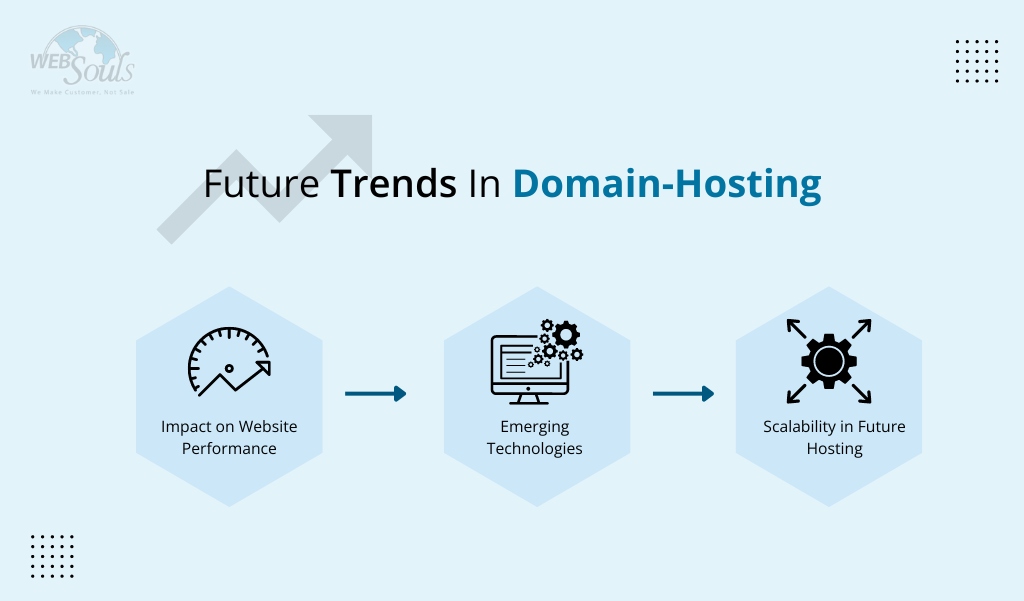
1. Emerging Technologies
Emerging technologies have the potential to completely change the domain hosting industry and the way websites are administered. The incorporation of artificial intelligence (AI) into web hosting solutions is one of the most notable developments.
Website administration is now much more automated and efficient thanks to AI-powered hosting.
These systems provide improved performance and responsiveness by analyzing user behavior, forecasting traffic patterns, and real-time resource allocation using machine learning algorithms. This enhances the user experience overall and speeds up the hosting process.
Additionally, blockchain technology is gaining traction in the name hosting industry by bringing safe, decentralized alternatives. Blockchain integration lowers the possibility of data breaches and illegal access by ensuring transparency and tamper-resistant records.
Blockchain-enabled web hosting platforms that employ smart contracts to automate agreements and transactions promote dependability and confidence in the administration of digital assets.
Looking ahead, a harmonic combination of blockchain technology and artificial intelligence appears to be shaping the future of website administration, offering a more reliable, effective, and safe web hosting environment.
The continuous advancements in these technologies portend a new era of digital presence management, one in which website owners will have access to intelligent, decentralized, and seamless hosting options.
2. Impact on Website Performance
Speed, security, and user experience are just a few of the many aspects that make up the dynamic and complex world of how changing technologies affect website performance.
Websites must constantly change in order to remain effective and relevant as technology progresses.
A critical component is the domain hosting infrastructure, where trends are essential in determining the nature of the internet.
Emerging technologies that are transforming the pace at which material is delivered to users include edge computing and material Delivery Networks (CDNs). CDNs improve load times and lower latency by distributing website content among several servers throughout the world.
Response times are further accelerated by the inclusion of edge computing, which moves processing capacity closer to the consumer. Another worry is security, and trends for the future point to a move toward stronger protocols like DNS over HTTPS (DoH) and improvements to TLS.
With the usage of these technologies, users' communications with websites will be encrypted, protecting private information and preventing harmful activity.
The development of artificial intelligence (AI) and machine learning algorithms is expected to have a positive impact on the user experience, which is essential to the success of websites.
By analyzing user behavior, forecasting preferences, and customizing content delivery, these technologies make for a more engaging and customized user experience.
Innovations such as blockchain-based web hosting solutions and serverless architecture may cause paradigm shifts in the field of future domain-hosting trends. Serverless architecture eliminates the need for traditional servers, allowing websites to scale dynamically.
Blockchain, with its decentralized and tamper-resistant nature, has the potential to enhance security and reliability in domain & hosting, reducing the vulnerability to single points of failure.
3. Scalability in Future Hosting
Scalability is at the forefront of future hosting trends, representing the core of an infrastructure that can easily grow and contract to meet varied levels of traffic and data.
The exponential growth of digital interactions, along with the rising complexity of online services, highlights the importance of scalable hosting solutions.
Cloud-based architectures, containerization, and serverless computing are becoming more important components of this transition, allowing organizations to deploy resources more effectively and respond to demand spikes.
By adopting these trends, businesses guarantee that their online presence stays flexible and adaptive, creating a climate in which growth is not just tolerated but celebrated as a necessary component of digital success.
8. Conclusion
1. Summary of Key Steps
To summarize, attaining seamless domain-hosting integration is critical for a successful online presence, and "Mastering the Web: A Comprehensive Guide to Domain-Hosting Harmony" provides a road map for navigating this complex process.
To recap the important stages discussed in the article, start by carefully picking a reputable domain registrar and web hosting provider, making sure the two are compatible.
DNS settings must be configured precisely and securely to provide good communication between the domain and hosting servers. Additionally, prioritizing security measures such as SSL certificates improves the overall integrity of the connection.
As noted in the book, regular maintenance is critical in maintaining a harmonious connection between the domain and hosting, assuring optimal performance and security.
Furthermore, staying informed about emerging trends in the ever-evolving web landscape is indispensable for adapting to technological advancements and maintaining a competitive edge.
In essence, this comprehensive guide serves as a quick reference for users seeking a seamless integration of their domain and hosting, fostering a robust online presence.
2. Looking Ahead: Evolving Domain-Hosting Dynamics
The detailed and complex nature of domain-hosting dynamics necessitates recognizing the digital landscape transformation that is becoming increasingly restless.
The future holds a promise of unprecedented changes, driven by technological advancements and shifting user behaviors. In conclusion, it is important to look at upcoming trends and determine what the trajectory of domain hosting will be.
In forthcoming years, blockchain technology and artificial intelligence are expected to integrate into one another, thereby transforming security systems in place today while improving user experience.
As we stand on the brink of this paradigm shift in online operations, surviving companies must remain open to change and innovative thinking.
This shift requires online managers watching out for emerging trends, and being proactive towards changing digital challenges.


